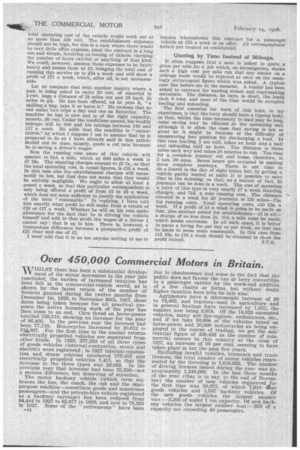Over 450,000 Commercial Motors in Britain.
Page 66

If you've noticed an error in this article please click here to report it so we can fix it.
VVIIILST there has been a substantial development of the motor movement in the year just concluded, the burden of increased taxation has been felt in the commercial-vehicle world, as is . shown by the latest return of the number of licences granted during the twelve months from December 1st, 1926, to November 30th, 1927, those dates being taken because for all practical purposes the active licensing werk of the year has then come to an end. Cars taxed on horse-power totalled 739,310, showing an increase for the year of 96,460. In the previous year the increase had been 77,110. Motorcycles increased by 20,612 to 51.4867. For the first time in the annual returns electrically propelled vehicles are separated from other kinds. In 1926, 257,283 of all three types of goods vehicles (internal-combustion, steam and electric) were registered ; in 1927 internal-combustion and steam vehicles numbered 279,857 and electrically propelled vehicles 1,415, so that the• increase in the three types was 23,989. In the previous year that increase had been 25,326—not a serious difference, but deserving of attention.
The motor hackney vehicle (which term embraces the bus, the coach, the cab and the dualpurpose machine—sometimes goods and sometimes passengers—and the private-hire vehicle registered as a hackney carriage) has been reduced from 84,444 in 1925 to 82,677 in 1926, and now to 78,283 in 1927. Some of the " retirements " have been r.44 due to obsolescence and some to the fact that the 'public does not favour the van or lorry convertible to a passenger carrier by the week-end additicin of a few chairs or forms, but without doubt higher taxation here tells its tale also. Agrimotors have a microscopic increase of 98 to 16,402, and tractors -used in agriculture and in general haulage have increased by 1,022, the number. now being 3,878. Of the 18,920 exempted vehicles, many are fire-engines, ambulances, etc., and if we take 50,000 of the vehicles taxed on horse-power and 20,000 motorcycles as being employed in the course of trading, we get the sub: stantial figure of 450,433 as the number of commercial motors in this country at the close of 1927, an increase of 50 per cent. seeming to have taken place in but the past few years.
Excluding invalid vehicles, tramcars and trade licences, the total number of motor vehicles represented by the licensing is 1,656,932. The number of driving licences issued during the year was approximately 2,349,000. In the last three months of the year (that is to say, to the end of November) the number of new vehicles registered or the first time was 50,672, of which 7,910 'Mere goods vehicles and 1,507 hackney vehicles. Of the new goods, vehicles the largest number was :-3.266 of under 1 ton capacity. Of new hackney vehicles the largest number was :-355-. of a capacity not exceeding 40 passengers.












































































































